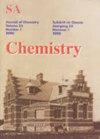A journey of 10 years in analytical method development and environmental monitoring of pharmaceuticals in South African waters
IF 1
4区 化学
Q4 CHEMISTRY, MULTIDISCIPLINARY
South African Journal of Chemistry-Suid-Afrikaanse Tydskrif Vir Chemie
Pub Date : 2023-01-01
DOI:10.17159/0379-4350/2023/v77a11
引用次数: 0
Abstract
Apart from the studies which reported the occurrence of steroid hormones and antibiotics in wastewater treatment plants (WWTPs) back in 2004, 2007 and 2012, the evidence for monitoring of pharmaceuticals in South African water bodies intensified from 2014. Therefore, this study reviewed the analytical methods developed and applied in South Africa for the purpose of monitoring pharmaceuticals and their metabolites in water. At the same time, pharmaceuticals and their metabolites detected in South African waters are reviewed. To date, there is over 100 pharmaceuticals detected in South African waters with most studies focussing on quantitative analysis of non-steroidal anti-inflammatory drugs (NSAID), antibiotics, antiretroviral drugs and carbamazepine. Various sources of pharmaceuticals in the environment are reported, with WWTPs found as the major contributor to their occurrence in South African rivers. Notably, a NSAID, ibuprofen, with concentrations found exceeding 100 μg L-1 in selected WWTPs has also been found at high levels reaching 60 μg L-1 in river water. Mostly, pharmaceuticals detected in wastewater are also reported in corresponding rivers. The present review details pharmaceuticals that should be included in environmental monitoring studies performed in South Africa, while also identifying areas for future research through the research gap analysis.为期10年的南非水域药物分析方法开发和环境监测之旅
除了早在2004年、2007年和2012年就报道了废水处理厂(WWTPs)中存在类固醇激素和抗生素的研究外,从2014年开始,南非水体中药物监测的证据越来越多。因此,本研究综述了南非为监测水中药物及其代谢物而开发和应用的分析方法。同时,回顾了在南非水域检测到的药物及其代谢物。迄今为止,在南非水域检测到100多种药物,大多数研究集中于非甾体抗炎药(NSAID)、抗生素、抗逆转录病毒药物和卡马西平的定量分析。据报道,环境中药物的各种来源,污水处理厂被发现是南非河流中药物出现的主要原因。值得注意的是,一种非甾体抗炎药布洛芬在某些污水处理剂中的浓度超过100 μg L-1,在河水中的浓度也高达60 μg L-1。大多数情况下,在废水中检测到的药物也报告在相应的河流中。本综述详细介绍了在南非进行的环境监测研究中应该包括的药物,同时还通过研究差距分析确定了未来研究的领域。
本文章由计算机程序翻译,如有差异,请以英文原文为准。
求助全文
约1分钟内获得全文
求助全文
来源期刊
CiteScore
3.10
自引率
0.00%
发文量
6
审稿时长
>12 weeks
期刊介绍:
Original work in all branches of chemistry is published in the South African Journal of Chemistry. Contributions in English may take the form of papers, short communications, or critical reviews.

 求助内容:
求助内容: 应助结果提醒方式:
应助结果提醒方式:


